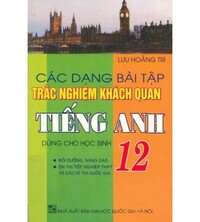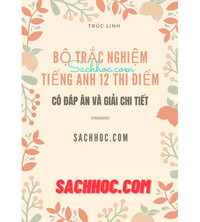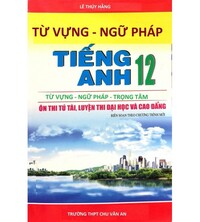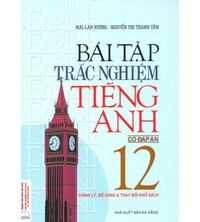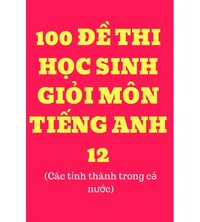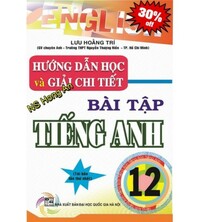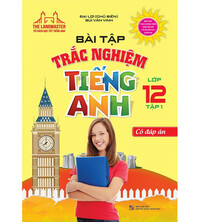Vocabulary - Unit 2. A multicultural world - SBT Tiếng Anh 12 Global Success
1 Circle the letter A, B, C, or D to indicate the word CLOSEST in meaning to the underlined word in each of the following questions.2 Circle the letter A, B, C, or D to indicate the word OPPOSITE in meaning to the underlined word in each of the following questions.
Bài 1
1 Circle the letter A, B, C, or D to indicate the word CLOSEST in meaning to the underlined word in each of the following questions.
(Khoanh tròn chữ cái A, B, C hoặc D để chỉ từ ĐỒNG NGHĨA nhất với từ được gạch chân trong mỗi câu hỏi sau.)
1. My grandfather was amazed to find six ancient silver coins in his garden.
A. traditional
B. modern
C. old
D. special
2. It is the custom in that country for women to marry at a young age.
A. choice
B. rule
C. practice
D. exception
3. Taking part in exchange programmes teaches students to respect the diversity of other cultures.
A. limitation
B. variety
C. similarity
D. agreement
4. A national identity represents a person's sense of belonging to a state or culture.
A. characteristic
B. diversity
C. nation
D. location
Lời giải chi tiết:

1. C
A. traditional (adj): truyền thống
B. modern (adj): hiện đại
C. old (adj): cũ
D. special (adj): đặc biệt
My grandfather was amazed to find six ancient silver coins in his garden.
(Ông tôi rất ngạc nhiên khi tìm thấy sáu đồng bạc cổ trong vườn nhà ông.)
“ancient” (cổ xưa) = old: cũ
Chọn C
2. C
A. choice (n): sự lựa chọn
B. rule (n): luật lệ
C. practice (n): tập tục
D. exception (n): ngoại lệ
It is the custom in that country for women to marry at a young age.
(Ở đất nước đó, phụ nữ có phong tục kết hôn khi còn trẻ.)
“custom” = practice: phong tục
Chọn C
3. B
A. limitation (n): giới hạn
B. variety (n): đa dạng
C. similarity (n): sự tương đồng
D. agreement (n): sự đồng ý
Taking part in exchange programmes teaches students to respect the diversity of other cultures.
(Tham gia vào các chương trình trao đổi dạy cho sinh viên tôn trọng sự đa dạng của các nền văn hóa khác.)
“diversity” = variety: sự đa dạng
Chọn B
4. A
A. characteristic (n): đặc trưng
B. diversity (n): đa dạng
C. nation (n): quốc gia
D. location (n): vị trí
A national identity represents a person's sense of belonging to a state or culture.
(Bản sắc dân tộc thể hiện ý thức của một người thuộc về một quốc gia hoặc nền văn hóa.)
“identity” = characteristic: đặc trưng
Chọn A
Bài 2
2 Circle the letter A, B, C, or D to indicate the word OPPOSITE in meaning to the underlined word in each of the following questions.
(Khoanh tròn chữ cái A, B, C hoặc D để chỉ từ TRÁI NGHĨA của từ được gạch chân trong mỗi câu hỏi sau.)
1. This restaurant serves the most delicious steak in the region.
A. tasty
B. yummy
C. tasteless
D. average
2. Americans often eat turkey at their traditional Thanksgiving dinner.
A. modern
B. ancient
C. old
D. antique
3. Pizza is a popular food among young people in Hong Kong.
A. famous
B. unknown
C. trendy
D. leading
4. My cousin has lived in Italy for five years and has learnt the language, but still sounds foreign.
A. adopted
B. global
C. universal
D. native
Lời giải chi tiết:

1. C
A. tasty (adj): ngon
B. yummy (adj): ngon
C. tasteless (adj): vô vị
D. average (adj): trung binh
This restaurant serves the most delicious steak in the region.
(Nhà hàng này phục vụ món bít tết ngon nhất trong vùng.)
“delicious” (ngon) >< tasteless (vô vị)
Chọn C
2. A
A. modern (adj): hiện đại
B. ancient (adj): cổ xưa
C. old (adj): cũ
D. antique (adj): cổ
Americans often eat turkey at their traditional Thanksgiving dinner.
(Người Mỹ thường ăn gà tây trong bữa tối Lễ Tạ ơn truyền thống của họ.)
“traditional” (truyền thống) >< modern (hiện đại)
Chọn A
3. B
A. famous (adj): nổi tiếng
B. unknown (adj): không được biết đến
C. trendy (adj): trào lưu
D. leading (adj): dẫn đầu
Pizza is a popular food among young people in Hong Kong.
(Pizza là món ăn được giới trẻ Hong Kong ưa chuộng.)
“popular” (nổi tiếng) >< unknown (không được biết đến)
Chọn B
4. D
A. adopted (adj): được thông qua
B. global (adj): toàn cầu
C. universal (adj): phổ biến
D. native (adj): bản địa
My cousin has lived in Italy for five years and has learnt the language, but still sounds foreign.
(Anh họ của tôi đã sống ở Ý được năm năm và đã học được ngôn ngữ này nhưng vẫn nghe có vẻ xa lạ.)
“foreign” (xa lạ) >< native (bản địa)
Chọn D
Bài 3
3 Circle the letter A, B, C, or D to indicate the correct answer to each of the following questions.
(Khoanh tròn chữ cái A, B, C hoặc D để chỉ câu trả lời đúng cho mỗi câu hỏi sau.)
1. Food in Singapore has been influenced by different cultures, so you can find a wide variety of _____ in the city.
A. languages
B. cuisines
C. cooking
D. views
2. There are many ways for foreign students to deal with _____ and adjust to the new environment.
A. globalisation
B. cultural group
C. culture shock
D. youth culture
3. The UK is a _____ society where different ethnic groups are required to contribute to the country, but can maintain their national identity.
A. historical
B. popular
C. musical
D. multicultural
4. The modern Christmas tree has its _____ in 16th-century Germany.
A. custom
B. tradition
C. origin
D. practice
5. Some people think that globalisation is a threat to _____ cultures.
A. traditional
B. new
C. modern
D. current
6. The ao dal, the traditional long dress for women, has become a symbol of Vietnamese _____ and culture.
A. people
B. identity
C. location
D. voice
7. The _____ lasted four days and included a parade, several concerts, and a dance party.
A. trends
B. origins
C. festivities
D. attractions
8. To avoid culture shock, learn about the _____ and behaviour of local people in advance.
A. experiences
B. cultures
C. performances
D. customs
Lời giải chi tiết:
 1. B
1. B
A. languages (n): ngôn ngữ
B. cuisines (n): nền ẩm thực
C. cooking (n): việc nấu ăn
D. views (n): lượt xem
Food in Singapore has been influenced by different cultures, so you can find a wide variety of cuisines in the city.
(Ẩm thực ở Singapore chịu ảnh hưởng của các nền văn hóa khác nhau, vì vậy bạn có thể tìm thấy rất nhiều nền ẩm thực đa dạng trong thành phố.)
Chọn B
2. C
A. globalisation (n): toàn cầu hóa
B. cultural group (n): nhóm văn hóa
C. culture shock (n): sốc văn hóa
D. youth culture (n): văn hóa thanh niên
There are many ways for foreign students to deal with culture shock and adjust to the new environment.
(Có nhiều cách để sinh viên nước ngoài đối phó với cú sốc văn hóa và thích nghi với môi trường mới.)
Chọn C
3. D
A. historical (adj): thuộc về lịch sử
B. popular (ad): phổ biến
C. musical (adj): âm nhạc
D. multicultural (adj): đa văn hóa
The UK is a multicultural society where different ethnic groups are required to contribute to the country, but can maintain their national identity.
(Vương quốc Anh là một xã hội đa văn hóa, nơi các nhóm dân tộc khác nhau được yêu cầu đóng góp cho đất nước nhưng vẫn có thể duy trì bản sắc dân tộc của mình.)
Chọn D
4. C
A. custom (n): phong tục
B. tradition (n): truyền thống
C. origin (n): nguồn gốc
D. practice (n): tục lệ
The modern Christmas tree has its origin in 16th-century Germany.
(Cây Giáng sinh hiện đại có nguồn gốc từ nước Đức thế kỷ 16.)
Chọn C
5. A
A. traditional (adj): truyền thống
B. new (adj): mới
C. modern (adj): hiện đại
D. current (adj): hiện tại
Some people think that globalisation is a threat to traditional cultures.
(Một số người cho rằng toàn cầu hóa là mối đe dọa đối với các nền văn hóa truyền thống.)
Chọn A
6. B
A. people (n): mọi người
B. identity (n): đặc trưng
C. location (n): vị trí
D. voice (n): giọng nói
The ao dai, the traditional long dress for women, has become a symbol of Vietnamese identity and culture.
(Áo dài truyền thống của phụ nữ đã trở thành biểu tượng của bản sắc và văn hóa Việt Nam.)
Chọn B
7. C
A. trends (n): xu hướng
B. origins (n): nguồn gốc
C. festivities (n): lễ hội
D. attractions (n): điểm tham quan
The festivities lasted four days and included a parade, several concerts, and a dance party.
(Lễ hội kéo dài bốn ngày và bao gồm một cuộc diễu hành, một số buổi hòa nhạc và một bữa tiệc khiêu vũ.)
Chọn C
8. D
A. experiences (n): trải nghiệm
B. cultures (n): văn hóa
C. performances (n): màn biểu diễn
D. customs (n): phong tục
To avoid culture shock, learn about the customs and behaviour of local people in advance.
(Để tránh bị sốc văn hóa, hãy tìm hiểu trước về phong tục, ứng xử của người dân địa phương.)
Chọn D
Bài 4
4 Complete the sentences using the correct form of the words in brackets.
(Hoàn thành câu sử dụng dạng đúng của từ trong ngoặc.)
1. K-pop has changed from a local ________ to a global phenomenon. (trendy)
2. Halloween is quite ________ among young people in many Asian countries now. (popularity)
3. One of the main disadvantages of ________ diversity is that it may create language barriers. (culture)
4. As home to people from many countries, London is one of the most culturally ________ cities in the world. (diversity)
5. _______ cultures often place greater importance on personal freedom and independence. (west)
6. My parents encourage me to read books and newspapers to gain general ________ (know)
7. People in the Middle Ages ________ Christmas with 12 full days of festivities. (celebration)
8. The Eiffel Tower in Paris is the most-visited tourist ________ in the world. (attract)
Lời giải chi tiết:

1. trend
Sau mạo từ “a” và sau tính từ “local” (địa phương) cần danh từ.
trendy (adj): hợp thời
=> trend (n): trào lưu
K-pop has changed from a local trend to a global phenomenon.
(K-pop đã chuyển từ xu hướng địa phương sang hiện tượng toàn cầu.)
Đáp án: trend
2. popular
Sau động từ tobe “is” cần một tính từ.
popularity (n): sự phổ biến
=> popular (adj): phổ biến
Halloween is quite popular among young people in many Asian countries now.
(Halloween hiện nay khá phổ biến trong giới trẻ ở nhiều nước châu Á.)
Đáp án: popular
3. cultural
Trước danh từ “diversity” (sự đa dạng) cần một tính từ.
culture (n): văn hóa
=> cultural (adj):
One of the main disadvantages of cultural diversity is that it may create language barriers.
(Một trong những nhược điểm chính của sự đa dạng văn hóa là nó có thể tạo ra rào cản ngôn ngữ.)
Đáp án: cultural
4. diverse
Trước danh từ “cities” (những thành phố) cần một tính từ.
diversity (n): sự đa dạng
=> diverse (adj): đa dạng
As home to people from many countries, London is one of the most culturally diverse cities in the world.
(Là nơi sinh sống của người dân từ nhiều quốc gia, London là một trong những thành phố có nền văn hóa đa dạng nhất trên thế giới.)
Đáp án: diverse
5. western
west (n): hướng tây
=> western (adj): thuộc về phương tây
Western cultures often place greater importance on personal freedom and independence.
(Các nền văn hóa phương Tây thường coi trọng sự tự do và độc lập cá nhân hơn.)
Đáp án: western
6. knowledge
Sau tính từ “general” (tổng quát) cần một danh từ.
know (v): biết
=> knowledge (n): kiến thức
My parents encourage me to read books and newspapers to gain general knowledge.
(Bố mẹ tôi khuyến khích tôi đọc sách báo để có được kiến thức tổng quát.)
Đáp án: knowledge
7. celebrated
Sau chủ ngữ “people” (mọi người) cần một động từ chia thì.
celebration (n): lễ hội
=> celebrate (v): tổ chức
Dấu hiệu thì quá khứ “in the Middle Ages” (thời Trung cổ) => Cấu trúc thì quá khứ đơn: S + V2/ed.
People in the Middle Ages celebrated Christmas with 12 full days of festivities. (celebration)
(Người dân thời Trung cổ tổ chức lễ Giáng sinh với 12 ngày lễ hội trọn vẹn.)
Đáp án: celebrated
8. attraction
Sau danh từ “tourist” (du khách) cần một danh từ để tạo thành danh từ ghép.
attract (v): thu hút
=> attraction (n): điểm thu hút
The Eiffel Tower in Paris is the most-visited tourist attraction in the world.
(Tháp Eiffel ở Paris là địa điểm du lịch được ghé thăm nhiều nhất trên thế giới.)
Đáp án: attraction
Search google: "từ khóa + timdapan.com" Ví dụ: "Vocabulary - Unit 2. A multicultural world - SBT Tiếng Anh 12 Global Success timdapan.com"
